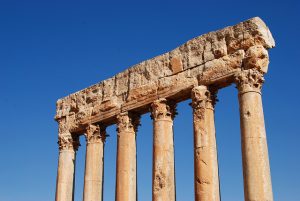Lebanese Art
I moved back to Lebanon somewhat recently, returning to the country in which I was born and spent a good deal of my youth. When you’ve grown up in a country and experienced it first-hand, sometimes it’s easy to take it for granted. When I left Lebanon as an adult to explore options elsewhere, I missed the country. Upon my eventual return, I was able to experience the culture, art and life of Lebanon all over again, allowing myself to open my eyes to what was going on around me.
If you’ve ever set foot in Lebanon you’ve undoubtedly experienced the rich and diverse culture and artistic ambiance that exists across the country. Exploring it piece by piece allows us to learn more about not only the history of the country and its people, but also the culture and intricacies that surround and exist within everyone there.
Ancient Architecture of Lebanon
When examining the culture and history of a country, one of the most straightforward means of understanding the historical art is in the buildings and monuments that adorn it.
Viewing some of the architecture of Lebanon lends some immediate insight into the past. Perhaps the most noteworthy aspect of Lebanese architecture isn’t found by looking at any one building, nor by any one set of buildings. The true power and beauty of the buildings around Lebanon does not lie entirely in how they are built or how the facades appear, it’s the incredible diversity found throughout the nation. The numerous people who have inhabited what is now Lebanon throughout the history of the world have each left their mark on the beautiful country, its art, and of course its buildings.
The former occupants of the country during early history–the Romans, the Ottomans, the French, etc each imparted their history into that of Lebanon, creating an amalgamation of beauty that is hard to find elsewhere. The styles and influences that made those ruling powers what they were has clearly rubbed off on modern Lebanese culture.
Roman Architecture
Lebanon–particularly in Baalbek–is home to some of the most beautiful and ornate Roman temples built long, long ago. The Jupiter Temple was built in Baalbek, a small city which was a part of a trade route in ancient times. The placement is interesting, as the city had little significance to the Romans, and while all but six of the original columns have fallen with time, the temple remains and is still a sight to be seen.

Photo via Karan Jain, Flickr
Castles
If you truly explore the reaches of Lebanon you will undoubtedly notice the stone castles that are strewn throughout the country. Looking at the castles can paint a historical picture, so if learning about the past interests you, consider visiting places like Sidon. Know for the Castle of Sidon (Sea Castle) which was built by Crusaders around 1228, the castle sits not far from the beach and offers and incredible view of the water and the city.
The above is hardly the only architecture that Lebanon has to offer–and it is certainly not the only historical art. This is merely the first of many posts that will uncover some of the most beautiful and noteworthy pieces of Lebanese culture that you too can experience should you choose to arrange a visit.
